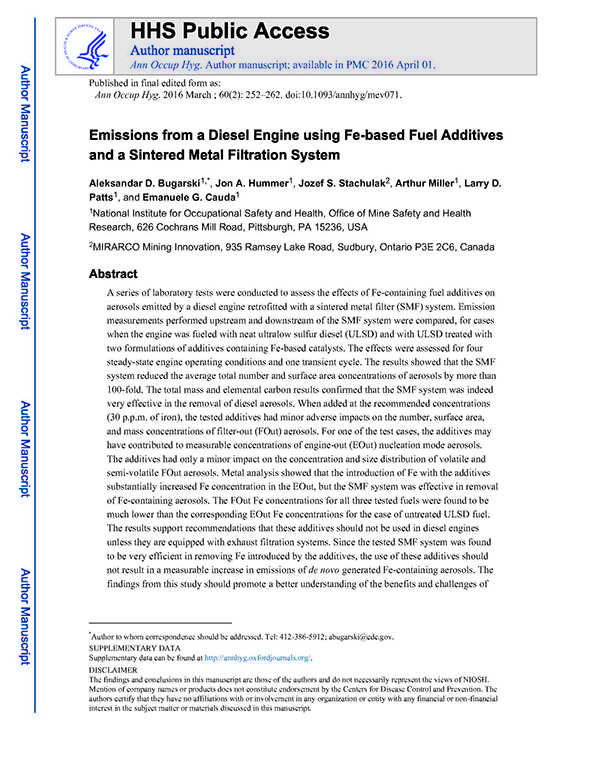Mining Publication: Emissions from a Diesel Engine using Fe-based Fuel Additives and a Sintered Metal Filtration System
Original creation date: March 2016
A series of laboratory tests were conducted to assess the effects of Fe-containing fuel additives on aerosols emitted by a diesel engine retrofitted with a sintered metal filter (SMF) system. Emission measurements performed upstream and downstream of the SMF system were compared, for cases when the engine was fueled with neat ultralow sulfur diesel (ULSD) and with ULSD treated with two formulations of additives containing Fe-based catalysts. The effects were assessed for four steady-state engine operating conditions and one transient cycle. The results showed that the SMF system reduced the average total number and surface area concentrations of aerosols by more than 100-fold. The total mass and elemental carbon results confirmed that the SMF system was indeed very effective in the removal of diesel aerosols. When added at the recommended concentrations (30 p.p.m. of iron), the tested additives had minor adverse impacts on the number, surface area, and mass concentrations of filter-out (FOut) aerosols. For one of the test cases, the additives may have contributed to measurable concentrations of engine-out (EOut) nucleation mode aerosols. The additives had only a minor impact on the concentration and size distribution of volatile and semi-volatile FOut aerosols. Metal analysis showed that the introduction of Fe with the additives substantially increased Fe concentration in the EOut, but the SMF system was effective in removal of Fe-containing aerosols. The FOut Fe concentrations for all three tested fuels were found to be much lower than the corresponding EOut Fe concentrations for the case of untreated ULSD fuel. The results support recommendations that these additives should not be used in diesel engines unless they are equipped with exhaust filtration systems. Since the tested SMF system was found to be very efficient in removing Fe introduced by the additives, the use of these additives should not result in a measurable increase in emissions of de novo generated Fe-containing aerosols. The findings from this study should promote a better understanding of the benefits and challenges of using sintered metal systems and fuel additives to control the exposure of underground miners and other workers to diesel aerosols and gases.
Authors: AD Bugarski, JA Hummer, J Stachulak, AL Miller, LD Patts, E Cauda
Peer Reviewed Journal Article - March 2016
NIOSHTIC2 Number: 20046830
Ann Occup Hyg 2016 Mar; 60(2):252-262
See Also
- A Computer Software Program that Estimates Air Quantity Requirements in Large Opening Stone Mines
- Control Technologies and Strategies for Reducing Exposure of Underground Miners to Diesel Emissions
- DEEP Project on Evaluation of Diesel Particulate Filters at Inco's Stobie Mine
- Diesel Emissions Control Technologies in Coal Mines
- Diesel Emissions Control Technologies in Metal/Nonmetal Mines
- Effectiveness of Selected Diesel Particulate Matter Control Technologies for Underground Mining Applications: Isolated Zone Study, 2004
- Effects of Diesel Exhaust Aftertreatment Devices on Concentrations and Size Distribution of Aerosols in Underground Mine Air
- Evaluation of the SKC® DPM Cassette for Monitoring Diesel Particulate Matter in Coal Mines
- Mutagenicity of Diesel Exhaust Particles from an Engine with Differing Exhaust After Treatments
- Technology News 514 - The Air Quantity Estimator (AQE): A New Computer Software Tool for Large-opening Mine Ventilation Planning
- Content source: National Institute for Occupational Safety and Health, Mining Program


 ShareCompartir
ShareCompartir
